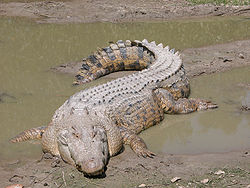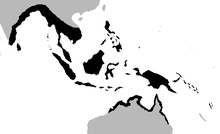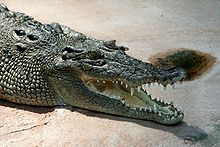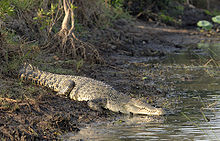- Saltwater crocodile
-
Saltwater Crocodile 
Conservation status Scientific classification Kingdom: Animalia Phylum: Chordata Class: Reptilia Order: Crocodylia Family: Crocodylidae Subfamily: Crocodylinae Genus: Crocodylus Species: C. porosus Binomial name Crocodylus porosus
(Schneider, 1801)
Range of the saltwater crocodile in black The saltwater crocodile, also known as estuarine or Indo-Pacific crocodile, (Crocodylus porosus) is the largest of all living reptiles. It is found in suitable habitats in Northern Australia, the eastern coast of India and parts of Southeast Asia.
Contents
Anatomy and morphology
The saltwater crocodile has a longer muzzle than the mugger crocodile: its length is twice its breadth at the base.[2] The saltwater crocodile has fewer armor plates on its neck than other crocodilians, and its broad body contrasts with that of most other lean crocodiles, leading to early unverified assumptions that the reptile was an alligator.[3]
Newly hatched saltwater crocodiles measure about 25 to 30 centimetres (9.8–12 in) long and weigh an average of 70 grams (2.5 oz).[4] Males reach sexual maturity at around 3.3 metres (11 ft) at around 16 years of age, while females reach sexual maturity at 2.1 metres (6.9 ft) and 12–14 years.[5] An adult male saltwater crocodile's weight is 409 to 1,000 kilograms (900–2,200 lb) and length is normally 4.1 to 5.5 metres (13–18 ft), although mature males can exceed 6 metres (20 ft) and weigh more than 1,000 kilograms (2,200 lb).[6][7][8] Weight can vary enormously based upon condition and age, older males tending to outweigh younger ones since they maintain prime territories with access to better, more abundant prey. For example, crocodiles at 4.8 metres (16 ft) long have ranged in mass variously from 522 kilograms (1,150 lb) to 1,000 kilograms (2,200 lb).[8] This species has the greatest sexual dimorphism of any modern crocodilian, with females being much smaller than males. Typical female body lengths in the range of 2.3 to 3.5 metres (8–11 ft).[3][6] The largest female on record measured about 4.2 metres (14 ft).[8] The mean weight of the species as a whole is roughly 450 kilograms (1,000 lb).[9]
The largest size saltwater crocodiles can reach is the subject of considerable controversy. The longest crocodile ever measured snout-to-tail and verified was the skin of a dead crocodile, which was 6.2 metres (20 ft) long. As skins tend to shrink slightly after removal from the carcass, this crocodile's living length was estimated at 6.3 metres (21 ft), and it could have weighed more than 1,000 kilograms (2,200 lb).[10][11] Incomplete remains (the skull of a crocodile shot in Orissa)[12] have been claimed to come from a 7.6-metre (25 ft) crocodile, but scholarly examination suggested a length no greater than 7 metres (23 ft).[10] There have been numerous claims of crocodiles in the 9-metre (30 ft) range: the crocodile shot in the Bay of Bengal in 1840, reported at 10 metres (33 ft); another killed in 1823 at Jalajala on the main island of Luzon in the Philippines reported at 8.2 metres (27 ft); a reported 7.6 metres (25 ft) crocodile killed in the Hooghly River in the Alipore District of Calcutta. However, examinations of these animals' skulls actually indicated animals ranging from 6 to 6.6 metres (20–21.7 ft).[8]
With recent restoration of saltwater crocodile habitat and reduced poaching, it is possible that 7-metre (23 ft) crocodiles are alive today.[13] Guinness has accepted a claim of a 7-metre (23 ft), 2,000 kg (4,400 lb) male saltwater crocodile living within Bhitarkanika Park in the state of Orissa, India,[12][14] although, due to the difficulty of trapping and measuring a very large live crocodile, the accuracy of these dimensions has yet to be verified.
A crocodile shot in Queensland in 1957 was reported to be 8.63 metres (28.3 ft) long, but no verified measurements were made and no remains of this crocodile exist.[15][16] A "replica" of this crocodile has been made as a tourist attraction.[17][18][19] Many other unconfirmed reports of crocodiles exceeding 8 metres (28+ ft) have been made[20][21] but these are highly unlikely.[15]
Distribution
 Saltwater crocodile jumping up at Adelaide River
Saltwater crocodile jumping up at Adelaide River
The saltwater crocodile is one of the three crocodilians found in India, the other two being the Mugger crocodile and the Gharial.[22] Apart from the eastern coast of India, the saltwater crocodile is extremely rare in the Indian subcontinent. A huge population of saltwater crocodiles (consisting of many large adults, including a 7 meter male) is present within the Bhitarkanika Wildlife Sanctuary of Orissa and they are known to be present in smaller numbers throughout the Indian and Bangladesh portions of the Sundarbans.
In northern Australia (which includes the northernmost parts of the Northern Territory, Western Australia and Queensland) the Saltwater Crocodile is thriving, particularly in the multiple river systems near Darwin (such as the Adelaide, Mary and Daly Rivers, along with their adjacent billabongs and estuaries) where large (6 metre +) individuals are common. The Australian Saltwater Crocodile population is estimated at somewhere between 100,000 and 200,000 adults. Their range extends from Broome in Western Australia through the entire Northern Territory coast all the way down to Rockhampton in Queensland. The Alligator Rivers of Northern Australia are misnamed due to the resemblance of the saltwater crocodile to alligators as compared to freshwater crocodiles, which also inhabit the Northern Territory. In New Guinea they are also common, existing within the coastal reaches of virtually every river system in the country, along with all estuaries and mangroves. They are also present in varying numbers throughout the Bismarck Archipelago, the Kai Islands, the Aru Islands, the Maluku Islands, and many other islands within the region including Timor, and most islands within the Torres Strait.
The saltwater crocodile was historically found throughout South-east Asia but is now extinct throughout much of this range. This species has not been reported in the wild for decades in most of Indochina and is extinct in Thailand, Laos, Vietnam, and possibly Cambodia. The status of this species is critical within much of Myanmar, but there is a stable population of many large adults present in the Irrawaddy Delta.[23] It is probable that the only country in Indochina still harboring wild populations of this species is Myanmar. Although Saltwater Crocodiles were once very common in the Mekong Delta (from where they disappeared in the 1980s) and other river systems, the future of this species in Indochina is now looking grim. However, it is also the least likely of crocodilians to become globally extinct due to its wide distribution and almost pre-colonial population sizes in Northern Australia and New Guinea.
The population is sporadic in Indonesia and Malaysia with some areas harbouring large populations (Borneo and Sumatra, for example) and others with very small, at-risk populations (e.g., Peninsular Malaysia). Despite the close proximity to the crocodile hot-bed of northern Australia, crocodiles no longer exist in Bali. This species is also extinct on Lombok, Komodo and most of Java. A small population may remain within Ujung Kulon National Park in western Java. The saltwater crocodile is also present in very limited parts of the South Pacific, with an average population in the Solomon Islands, a very small and soon to be extinct population in Vanuatu (where the population officially stands at only three) and a decent but at-risk population (which may be rebounding) in Palau. Saltwater crocodiles once ranged as far west as the east coast of Africa at the Seychelles Islands. These crocodiles were once believed to be a population of Nile crocodiles, but they were later proven to be Crocodylus porosus.[3]
Due to its tendency to travel very long distances at sea, individual saltwater crocodiles occasionally show up in areas of which they are not native. Vagrant individuals have historically been reported on New Caledonia, Iwo Jima, Fiji, and even in the relatively frigid Sea of Japan (thousands of miles from their native territory.) In late 2008/early 2009 a handful of wild saltwater crocodiles were verified to be living within the river systems of Fraser Island, hundreds of kilometres from and in much cooler water than their normal Queensland range. It was discovered that these crocodiles did indeed migrate south to the island from northern Queensland during the warmer wet season and presumably returned to the north upon the seasonal temperature drop. Despite the surprise and shock within the Fraser Island public, this is apparently not new behaviour and in the distant past wild crocodiles had been reported occasionally appearing as far south as Brisbane during the warmer wet season.
Habitat
Saltwater crocodiles generally spend the tropical wet season in freshwater swamps and rivers, moving downstream to estuaries in the dry season, and sometimes travelling far out to sea. Crocodiles compete fiercely with each other for territory, with dominant males in particular occupying the most eligible stretches of freshwater creeks and streams. Junior crocodiles are thus forced into the more marginal river systems and sometimes into the ocean. This explains the large distribution of the animal (ranging from the east coast of India to northern Australia) as well as its being found in odd places on occasion (such as the Sea of Japan). Saltwater crocodiles can swim 15 to 18 miles per hour (6.7 to 8.0 m/s) in short bursts, but when cruising go 2 to 3 mph (0.9 to 1.3 m/s).
Diet and behaviour
 No Swimming sign from the Kakadu National Park.
No Swimming sign from the Kakadu National Park.
The saltwater crocodile is an opportunistic apex predator capable of taking nearly any animal that enters its territory, either in the water or on dry land. They are known to attack humans who enter the crocodiles' territory. Juveniles are restricted to smaller animals such as insects, amphibians, crustaceans, small reptiles, and fish. The larger the animal grows, the greater the variety of animals it includes in the diet, although relatively small prey make up an important part of the diet even in adults. Large adult saltwater crocodiles can potentially eat any animals within their range, including monkeys, kangaroos, wild boar, dingos, goannas, birds, domestic livestock, pets, humans, water buffalo, gaurs, bats, and even sharks.[13][24][25][26] Domestic cattle, horses, water buffalo, and gaur, all of which may weigh over a ton, are considered the largest prey taken by male crocodiles. Generally very lethargic – a trait which helps it survive months at a time without food – it typically loiters in the water or basks in the sun through much of the day, preferring to hunt at night. Saltwater crocodiles are capable of explosive bursts of speed when launching an attack from the water, but stories of crocodiles being faster than a race horse for short distances across the ground are little more than urban legend. At the water's edge, however, where they can combine propulsion from both feet and tail, eyewitness accounts are rare.
It usually waits for its prey to get close to the water's edge before striking, using its great strength to drag the animal back into the water. Most prey animals are killed by the great jaw pressure of the crocodile[citation needed], although some animals may be incidentally drowned. It is an extremely powerful animal; in one case, a one-tonne Suffolk stallion known to haul over two tonnes was pulled into water to its demise by a large male crocodile.[8] A large croc can crush a full-grown bovid's skull between its jaws. Its typical hunting technique is known as the "death roll": it grabs onto the animal and rolls powerfully. This throws any struggling large animal off balance, making it easier to drag it into the water. The "death roll" is also used for tearing apart large animals once they are dead.
Baby saltwater crocodiles may fall prey to monitor lizards, predatory fish, various aquatic and raptorial birds, larger crocodiles and other predators. Juveniles may also fall prey to tigers and leopards in certain parts of their range, although encounters between these predators are rare and cats are likely to usually avoid areas with saltwater crocodiles.
Intelligence
One researcher, Dr. Adam Britton,[27] has been studying crocodilian intelligence. He has compiled a collection of Australian saltwater crocodile calls,[28] and associated them with behaviors. His position is that while crocodilian brains are much smaller than those of mammals (as low as 0.05% of body weight in the saltwater crocodile), they are capable of learning difficult tasks with very little conditioning. He also infers that the crocodile calls hint at a deeper language ability than currently accepted. He suggests that saltwater crocodiles are clever animals that can possibly learn faster than lab rats. They have also learned to track the migratory route of their prey as the seasons change.
Attacks on humans
Data on attacks is limited outside of Australia. In Australia, attacks are rare and usually appear in national news publications when they do occur. There are approximately one to two fatal attacks reported per year in the country.[29] The low level of attacks may be due to extensive efforts by wildlife officials in Australia to post crocodile warning signs at many at-risk billabongs, rivers, lakes and beaches. In the large Aboriginal community of Arnhem Land, attacks may go unreported.[citation needed] There have also been recent, less-publicised attacks in Borneo,[30] Sumatra,[31] eastern India (Andaman Islands),[32][33] and in Myanmar.[34]
During the Japanese retreat in the Battle of Ramree Island on February 19, 1945, saltwater crocodiles may have been responsible for the deaths of 400 Japanese soldiers. British soldiers encircled the swampland through which the Japanese were retreating, condemning the Japanese to a night in the mangroves which was home to thousands of saltwater crocodiles. The Ramree crocodile attacks are listed under the heading "The Greatest Disaster Suffered from Animals" in Guinness World Records.[35] Another notorious crocodile attack was in 1985, on eco-feminist Val Plumwood.
See also
Notes
- ^ Crocodile Specialist Group (1996). "Crocodylus porosus". IUCN Red List of Threatened Species. Version 2011.1. International Union for Conservation of Nature. http://www.iucnredlist.org/apps/redlist/details/5668. Retrieved 20 August 2011.
- ^ Guggisberg, C.A.W. (1972). Crocodiles: Their Natural History, Folklore, and Conservation. p. 195. ISBN 0715352725.
- ^ a b c 'Crocodylus porosus' (Schneider, 1801), by Adam Britton from the Crocodilian Species List.
- ^ [1] (2011).
- ^ [2] (2011).
- ^ a b "Crocodilian Species – Australian Saltwater Crocodile (Crocodylus porosus)". Flmnh.ufl.edu. http://www.flmnh.ufl.edu/cnhc/csp_cpor.htm. Retrieved 2010-12-26.
- ^ "Saltwater Crocodile". Australianfauna.com. http://www.australianfauna.com/saltwatercrocodile.php. Retrieved 2010-08-18.
- ^ a b c d e Wood, Gerald (1983). The Guinness Book of Animal Facts and Feats. p. 256. ISBN 978-0-85112-235-9.
- ^ "Saltwater Crocodiles, Saltwater Crocodile Pictures, Saltwater Crocodile Facts – National Geographic". Animals.nationalgeographic.com. http://animals.nationalgeographic.com/animals/reptiles/saltwater-crocodile.html. Retrieved 2010-08-18.
- ^ a b http://crocodilian.com/cnhc/cbd-faq-q2.htm Crocodilian Biology Database. FAQ]
- ^ http://madrascrocbank.blogspot.com/2008/08/worlds-biggest-crocodiles.html
- ^ a b "Guinness: India Park Home to World's Largest Crocodile". UnderwaterTimes.com. http://www.underwatertimes.com/news.php?article_id=51790108324. Retrieved 2011-04-30..
- ^ a b "Seven-metre maneating crocodile shot dead". The Daily Telegraph. http://www.news.com.au/dailytelegraph/story/0,22049,21064163-5006003,00.html. Retrieved January 15, 2007.
- ^ World's Largest Reptile Found in India – OhmyNews International. English.ohmynews.com (2006-06-14). Retrieved on 2011-04-30.
- ^ a b "Monster croc? Welcome to my nightmare". The Sunday Mail (news.com.au). 28 November 2010. http://www.news.com.au/welcome-to-my-nightmare/story-e6frer76-1225961861480. Retrieved 2 April 2011.
- ^ Reid, Robert (28 November 2008). "Death of a monster". The Australian. http://www.theaustralian.com.au/news/health-science/death-of-a-monster/story-e6frg8gf-1111118162303. Retrieved 2 April 2011.
- ^ towns : QLD – NORMANTON – Home of largest Crocodile ever shot!. Give An Aussie A Go. Retrieved on 2011-04-30.
- ^ Krys the crocodile, Normanton, Queensland, ABC.net, 6 January 2004
- ^ Saltwater Crocodiles, Saltwater Crocodile Pictures, Saltwater Crocodile Facts – National Geographic. Animals.nationalgeographic.com. Retrieved on 2011-04-30.
- ^ Warm, fuzzy, weird, funny: The Museum(s) of Natural History spin some tall tales, Alvin Powell, Harvard Gazette, 19 July 2001
- ^ Saltwater Crocodile at National Geographic
- ^ Hiremath, K.G.. Recent advances in environmental science. Discovery Publishing House, 2003. ISBN 8171416799, 9788171416790.
- ^ "Crocodile kills man in wildlife sanctuary - World news - World environment - msnbc.com". MSNBC. 2008-04-20. http://www.msnbc.msn.com/id/24226179/. Retrieved 2010-08-18.
- ^ No Bull: Saltwater Crocodile Eats Shark. UnderwaterTimes.com. Retrieved on 2011-04-30.
- ^ photograph of crocodile eating a shark
- ^ Squires, Nick. (2007-09-04) Mother's tug-of-war with child-eating crocodile. Telegraph. Retrieved on 2011-04-30.
- ^ Big Gecko – Crocodile Management, Research and Filming. Crocodilian.com. Retrieved on 2011-04-30.
- ^ Crocodile Communication: Crocodiles, Caimans, Alligators, Gharials. Flmnh.ufl.edu (1996-03-05). Retrieved on 2011-04-30.
- ^ Caldicott, David G.E.; et al. (September 2005). "Crocodile Attack in Australia: An Analysis of Its Incidence and Review of the Pathology and Management of Crocodilian Attacks in General". Wilderness & Environmental Medicine 16 (3): 143–159. doi:10.1580/1080-6032(2005)16[143:CAIAAA]2.0.CO;2. http://www.wemjournal.org/article/S1080-6032(05)70380-X/abstract. Retrieved 20 August 2011.
- ^ "Search – Global Edition – The New York Times". International Herald Tribune. 2009-03-29. http://www.iht.com/articles/ap/2007/04/25/asia/AS-GEN-Malaysia-Crocodile-Attacks.php. Retrieved 2010-08-18.
- ^ "Woman saves daughter from crocodile", Telegraph.co.uk, 14 Mar 2008
- ^ Kalinga Times "Two injured in crocodile attack"
- ^ MSNBC TODAY "Croc kills woman 4 years after her sister’s death"
- ^ "Search – Global Edition – The New York Times". International Herald Tribune. 2009-03-29. http://www.iht.com/articles/ap/2008/04/20/asia/AS-GEN-Myanmar-Crocodile.php. Retrieved 2010-08-18.
- ^ "Massacre by Crocodiles on Ramree Island – Wild world – Nature, conservation and wildlife holidays". Iberianature.com. 1945-02-19. http://iberianature.com/wildworld/tag/massacre-by-crocodiles-on-ramree-island/. Retrieved 2010-08-18.
External links
- Recent Crocodile Attacks in Australia
- Saltwater crocodiles in freedom: Authentic pictures and descriptions
- Australian Saltwater Crocodile Photos and attack file
- Saltwater crocodile calls from Dr. Britton's crocodilian.com site
- Brief discussion from Dr. Britton and others discussing dromaeosaurid intelligence
Extant Crocodilian species Kingdom: Animalia · Phylum: Chordata · Class: Sauropsida · (unranked): Archosauria · Superorder: Crocodylomorpha Family Gavialidae Family Alligatoridae Alligatorinae
(Alligators)Caimaninae
(Caimans)Related articles on alligators, caimans, crocodiles and gharials Topics Human
interactionU.S. Alligator fatalities · Crocodile attacks · Alligator farm · Crocodile tears · Famous crocodiles and alligators · Sewer alligatorCategories:- IUCN Red List least concern species
- Crocodilians
- Crocodylidae
- Marine reptiles
- Reptiles of Australia
- Reptiles of Western Australia
- Reptiles of Bangladesh
- Reptiles of Brunei
- Reptiles of Cambodia
- Reptiles of India
- Reptiles of Indonesia
- Reptiles of Malaysia
- Reptiles of Burma
- Reptiles of Papua New Guinea
- Reptiles of the Philippines
- Reptiles of Sri Lanka
- Reptiles of Thailand
- Reptiles of Vietnam
- Megafauna of Australia
- Megafauna of Eurasia
Wikimedia Foundation. 2010.





